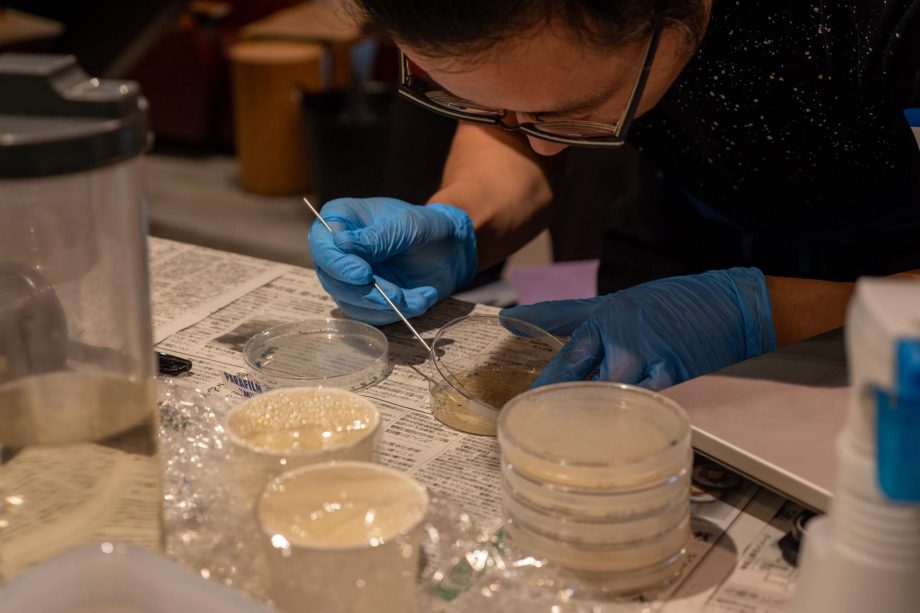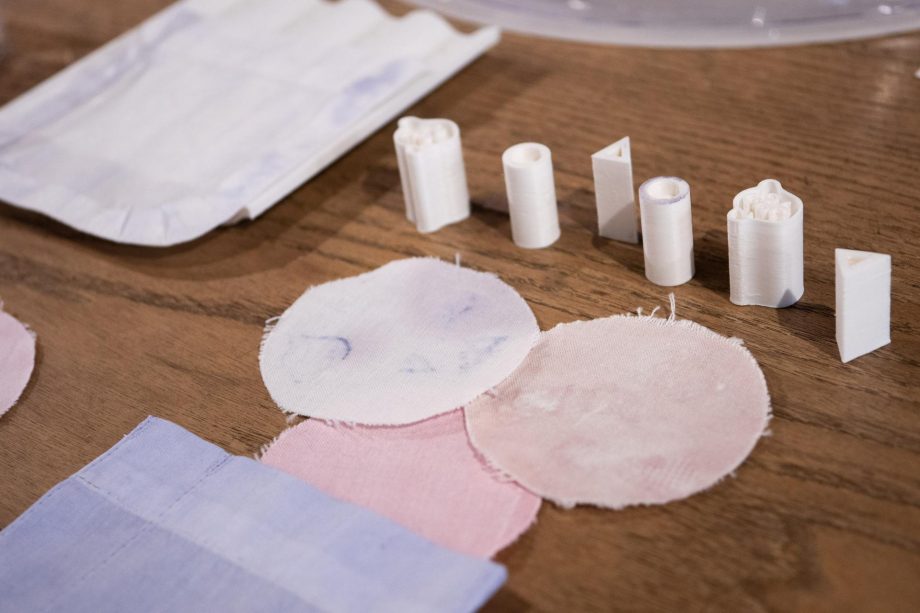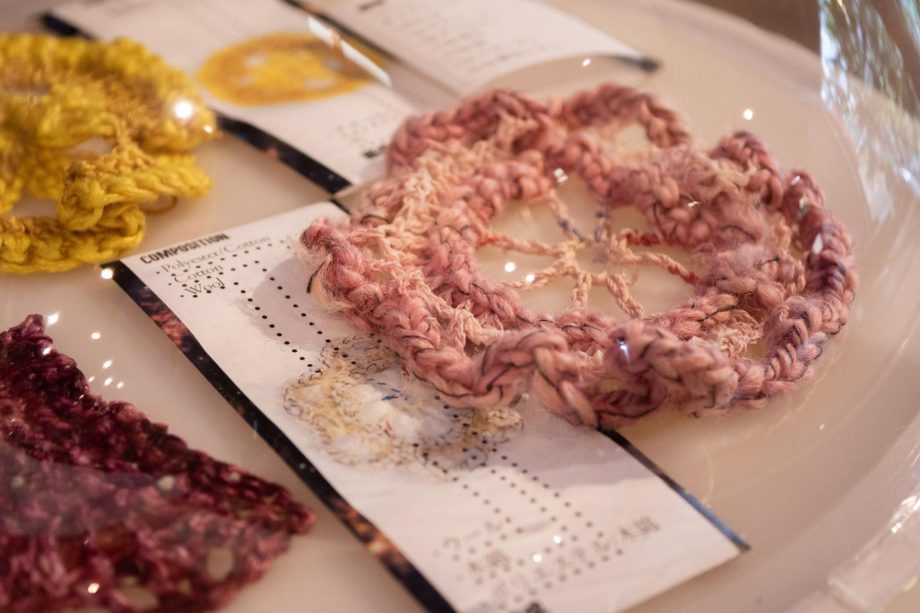Talk Event
- #Finished

In September 2023, 23 participants from a variety of backgrounds gathered in FabCafe Kyoto to learn how to cultivate bacteria through DIY methods. Bringing that newfound knowledge back home with petri dishes swabbed with pigment-producing strains, they embarked on a 6 week challenge to dye textiles with the bacteria. The results of this group experiment are displayed in an exhibition in Kyoto and Tokyo. For the closing night of the exhibition’s run in Tokyo, 4 of the participants will be sharing their experience and thoughts on the process.
Wed, December 6, 2023 UTC+09:00
19:00 – 20:30
FabCafe Tokyo | View on Google Map
Free we request all participants to order one drink
Bacteria has been touted as a new sustainable dyeing process that promises to use less land, water and produce less waste compared to traditional dyes. In Europe, a number of fashion houses such as LVMH and PUMA have started prototyping with it, but few, if any at all, have started in Japan.
To find out more about this method, SPCS interviewed Julia Moser in March 2023. Moser is a fashion designer working with Janthinobacterium Lividum and other bacteria to design new textiles and apparel. Her work with the bacteria explored the possibility of creating intentional patterns with bacterial dyes, foraging bacteria from the wild and testing their performance as fabric dyes, and even roping the bacteria in as a co-designer to contribute pattern shapes and knit textures through their growth patterns.
Reframing the View|Bacteria Improving Health in the Textile Industry
SPCS interviews Julia Moser on her research in a new sustainable form of dyeing
The Living Dyes workshop was then held in September 2023. It started as a way to open and further the conversation on textile design with bacteria in Japan, and explore the marriage of such novel techniques with traditional methods of dyeing. Under the guidance of Georg Tremmel, founder of BioClub Tokyo and WAAG lecturer, participants were encouraged to test out the best formulas for growing the particular pigment-producing strain and combine them with a variety of dyeing methods and materials.
-

Groups discuss what formula they should use to growth bacteria on.
-

Transferring the bacteria to new petri dishes on a DIY clean bench.
Despite the challenges of carrying out bacterial experiments in a DIY home setting, the participants came back with a number of works, dyeing not just various textiles and clothes but also stone, wood and rubber. Some also experimented with pattern creation, trying different ways to limit or encourage the growth of the bacteria.
Come hear from 4 of the participants knit-designer Muramoto Kaoru, makerspace organizer Momoko and researchers Hiroko Kaimoto and Carol as they share the process of working with living organisms to dye textiles and yarns.
-

Uraha’s tests out the bacteria pigment through traditional dye extraction and direct application methods.
-

Momoko plays with 3d-printed stamps and molds in her attempt to guide the bacteria into patterns
-

Based on previous research on genetically modified silkworms and their resulting fluorescent silk colours, Kaimoto tries to change the silk thread colours by changing silkworm feed with the bacteria’s pigments.
-

Carol experiments with bacterial cellulose and the pigmented bacteria in an attempt to see if they will co-exist and if the cellulose will be dyed.
- Apparel manufacturers and fashion houses who want to explore new technologies
- Product design and fashion students and researchers interested in sustainable initiatives in everyday products and apparel
- Artists and designers who want to experiment with new esoteric sustainable practices
- Textile dyers and textile designers who want to experiment with new dyes and dyeing methods
-
uraha (村本 かおり)
Works in the knitting industry.
Likes cats, yarn and the colour green.In 2023, she is trying to learn more about colours, taking a colour test and participating in a workshop to dye yarn a 100 colours.
She is always on the lookout for cute colour dyes that have a low environmental impact and can be dyed in her kitchen at home.
Works in the knitting industry.
Likes cats, yarn and the colour green.In 2023, she is trying to learn more about colours, taking a colour test and participating in a workshop to dye yarn a 100 colours.
She is always on the lookout for cute colour dyes that have a low environmental impact and can be dyed in her kitchen at home.
-
Sato Momoko
Currently runs a creative space for children and young people, while promoting a DIY textile recycling project.
I make my own tools to warp, re-spin and mill paper. When I was a student, my research was focused on Aspergillus mould and algae.
Currently runs a creative space for children and young people, while promoting a DIY textile recycling project.
I make my own tools to warp, re-spin and mill paper. When I was a student, my research was focused on Aspergillus mould and algae.
-
Hiroki Kaimoto
Graduate School of Interdisciplinary Information Studies, The University of Tokyo. PhD student
Based on his research on digital fabrication, he conducts research and produces artworks on the theme of changes in form produced by the characteristics of materials, interference with other materials and the forms produced by the accumulation of such interference.
Based on his research on digital fabrication, he conducts research and produces artworks on the theme of changes in form produced by the characteristics of materials, interference with other materials and the forms produced by the accumulation of such interference.
-
Carol
Carol is a Spanish designer currently based in Kyoto completing her MA degree in fashion design focusing on bacterial cellulose composite materials in the context of footwear. Her long-standing interest in living organisms intersects fashion, textiles and biology in its focus to develop working methodologies surrounding non-human stakeholders as co-designers, and in enhancing the artistic expression of these material innovations. By making use of new technologies intertwined with traditional design approaches, her work investigates the potential of bacterial cellulose as textile through experimental, multidisciplinary design proposals.
Carol is a Spanish designer currently based in Kyoto completing her MA degree in fashion design focusing on bacterial cellulose composite materials in the context of footwear. Her long-standing interest in living organisms intersects fashion, textiles and biology in its focus to develop working methodologies surrounding non-human stakeholders as co-designers, and in enhancing the artistic expression of these material innovations. By making use of new technologies intertwined with traditional design approaches, her work investigates the potential of bacterial cellulose as textile through experimental, multidisciplinary design proposals.
-
19:00 - 19:15
-
Introduction to SPCS and Living Dyes Workshop
-
19:15 - 19:30
-
Explanation of works by all 4 members
-
19:30 - 20:00
-
Panel discussion between members of SPCS Season 4 | Living Dyes (moderated by Sarah Ho)
-
20:00 - 20:30
-
Mixer
-
Date & Time
-
Wed, December 6, 2023 19:00 – 20:30 UTC+09:00
-
Venue
-
FabCafe Tokyo
150-0043 Dogenzaka, Shibuya-ku, Tokyo 1-22-7 Dogenzaka Pier 1F
tel. 03-6416-9190
https://fabcafe.com/jp/tokyo/
View on Google Map -
Fee
-
Free we request all participants to order one drink








